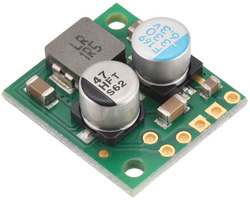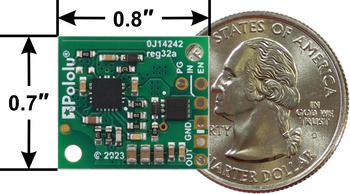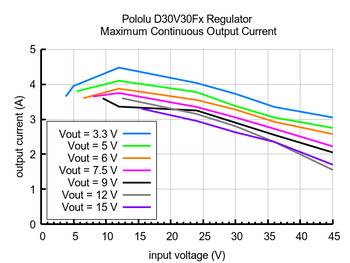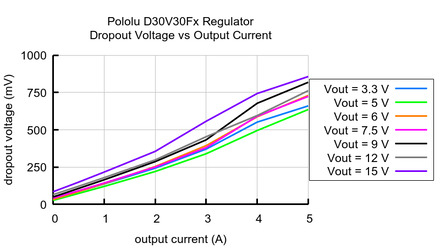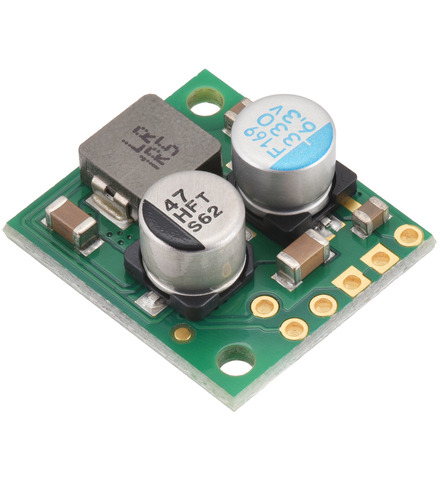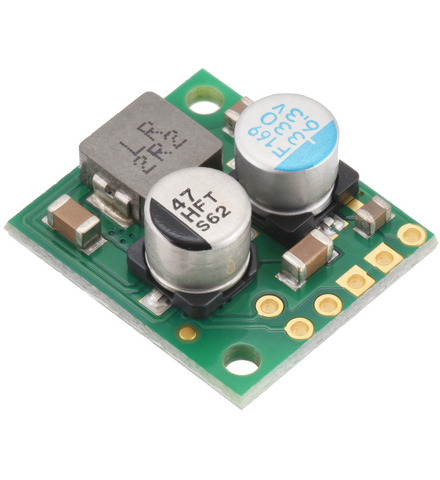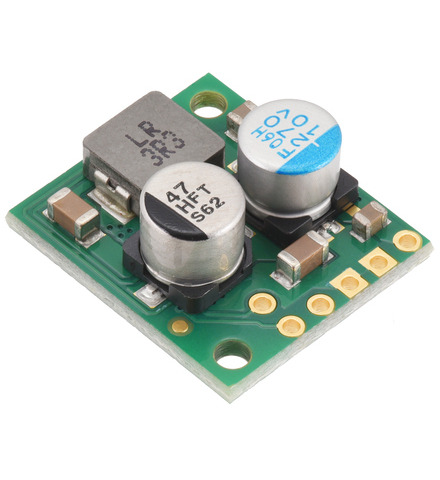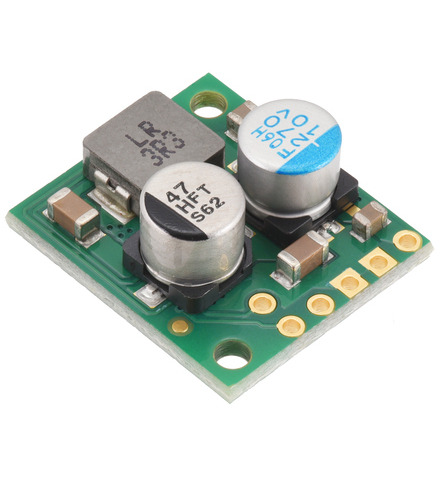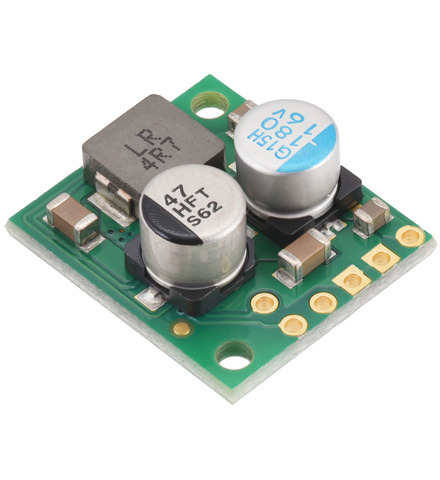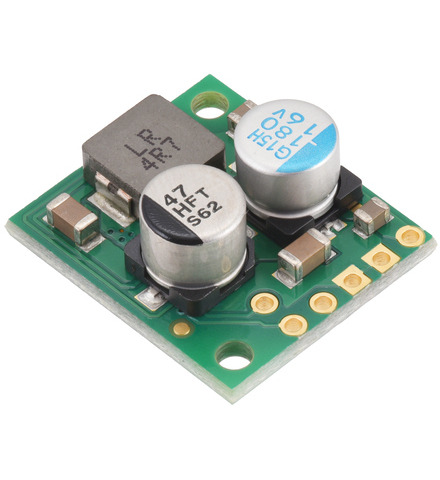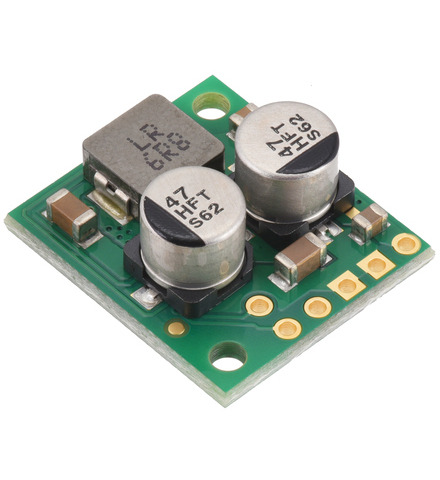The D30V30Fx family of buck (step-down) voltage regulators are compact, fixed-output members of the larger D30V3x line of synchronous regulators. They generate lower output voltages from input voltages as high as 45 V and can typically support continuous output currents between 2 A and 4 A, depending on the input voltage and output voltage. They also have very low dropout voltages.
The regulators have reverse voltage protection up to 40 V, input under-voltage lockout, over-current protection, and short-circuit protection. A thermal shutdown feature also helps prevent damage from overheating and a soft-start feature limits the inrush current and gradually ramps the output voltage on startup.
| Regulator |
Output voltage |
Typical max output current1 |
Input voltage range2 |
Size |
Special features |
Price |
| #4891: D30V30F3 |
3.3 V |
3.7 A |
3.3 V – 45 V |
0.7″ × 0.8″ |
Reverse voltage protection3,
input under-voltage lockout,
over-current protection,
short-circuit protection,
thermal shutdown,
soft-start |
$15.95 |
| #4892: D30V30F5 |
5 V |
3.4 A |
5 V – 45 V |
$15.95 |
| #4893: D30V30F6 |
6 V |
3.3 A |
6 V – 45 V |
$16.95 |
| #4894: D30V30F7 |
7.5 V |
3 A |
7.5 V – 45 V |
$16.95 |
| #4895: D30V30F9 |
9 V |
2.9 A |
9 V – 45 V |
$16.95 |
| #4896: D30V30F12 |
12 V |
2.8 A |
12 V – 45 V |
$16.95 |
| #4897: D30V30F15 |
15 V |
2.7 A |
15 V – 45 V |
$16.95 |
| Note 1: Typical continuous output current at 30 V in. Actual achievable continuous output current is a function of input voltage and is limited by thermal dissipation. See the output current graphs on the product pages for more information. |
| Note 2: Minimum input voltage is subject to dropout voltage considerations; see the dropout voltage section of product pages for more information. |
| Note 3: Reverse voltage protection up to -40 V. Connecting supplies over 40 V in reverse can damage the device. |
 Compare all products in this category
Compare all products in this category
Products in category “D30V30Fx Step-Down Voltage Regulators”
| Output voltage |
Typical max output current1 |
Input voltage range2 |
| 3.3 V |
3.7 A |
3.3 V – 45 V |
Note 1: Typical continuous output current at 30 V in. Actual achievable continuous output current is a function of input voltage and is limited by thermal dissipation. See the output current graphs on the product pages for more information.
Note 2: Minimum input voltage is subject to dropout voltage considerations; see the dropout voltage section of product pages for more information.
| Output voltage |
Typical max output current1 |
Input voltage range2 |
| 5 V |
3.4 A |
5 V – 45 V |
Note 1: Typical continuous output current at 30 V in. Actual achievable continuous output current is a function of input voltage and is limited by thermal dissipation. See the output current graphs on the product pages for more information.
Note 2: Minimum input voltage is subject to dropout voltage considerations; see the dropout voltage section of product pages for more information.
| Output voltage |
Typical max output current1 |
Input voltage range2 |
| 6 V |
3.3 A |
6 V – 45 V |
Note 1: Typical continuous output current at 30 V in. Actual achievable continuous output current is a function of input voltage and is limited by thermal dissipation. See the output current graphs on the product pages for more information.
Note 2: Minimum input voltage is subject to dropout voltage considerations; see the dropout voltage section of product pages for more information.
| Output voltage |
Typical max output current1 |
Input voltage range2 |
| 7.5 V |
3 A |
7.5 V – 45 V |
Note 1: Typical continuous output current at 30 V in. Actual achievable continuous output current is a function of input voltage and is limited by thermal dissipation. See the output current graphs on the product pages for more information.
Note 2: Minimum input voltage is subject to dropout voltage considerations; see the dropout voltage section of product pages for more information.
| Output voltage |
Typical max output current1 |
Input voltage range2 |
| 9 V |
2.9 A |
9 V – 45 V |
Note 1: Typical continuous output current at 30 V in. Actual achievable continuous output current is a function of input voltage and is limited by thermal dissipation. See the output current graphs on the product pages for more information.
Note 2: Minimum input voltage is subject to dropout voltage considerations; see the dropout voltage section of product pages for more information.
| Output voltage |
Typical max output current1 |
Input voltage range2 |
| 12 V |
2.8 A |
12 V – 45 V |
Note 1: Typical continuous output current at 30 V in. Actual achievable continuous output current is a function of input voltage and is limited by thermal dissipation. See the output current graphs on the product pages for more information.
Note 2: Minimum input voltage is subject to dropout voltage considerations; see the dropout voltage section of product pages for more information.
| Output voltage |
Typical max output current1 |
Input voltage range2 |
| 15 V |
2.7 A |
15 V – 45 V |
Note 1: Typical continuous output current at 30 V in. Actual achievable continuous output current is a function of input voltage and is limited by thermal dissipation. See the output current graphs on the product pages for more information.
Note 2: Minimum input voltage is subject to dropout voltage considerations; see the dropout voltage section of product pages for more information.
 Compare all products in this category
Compare all products in this category







